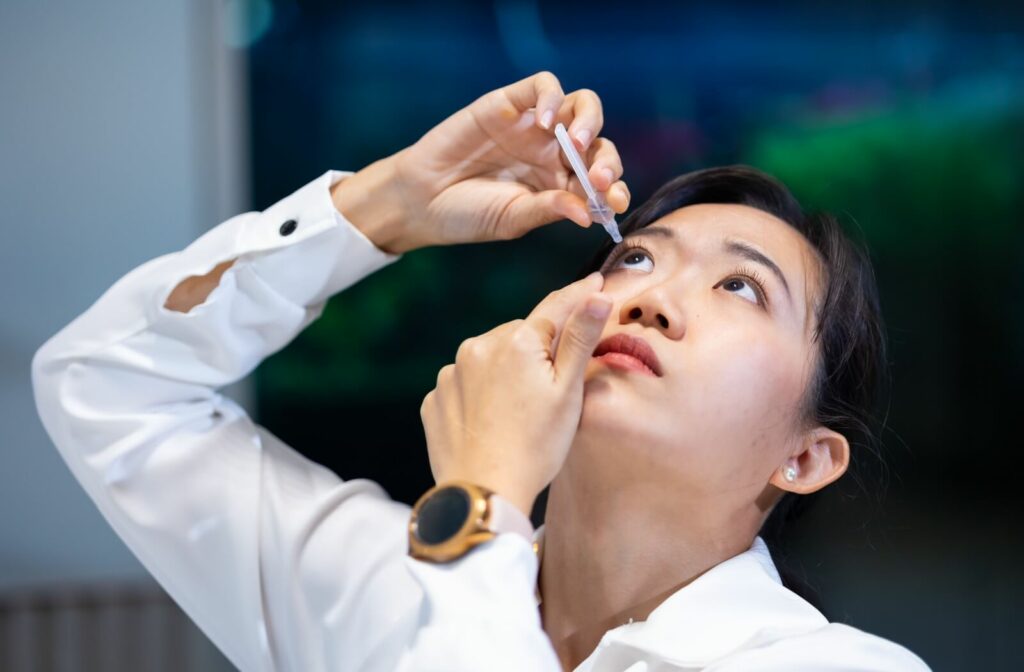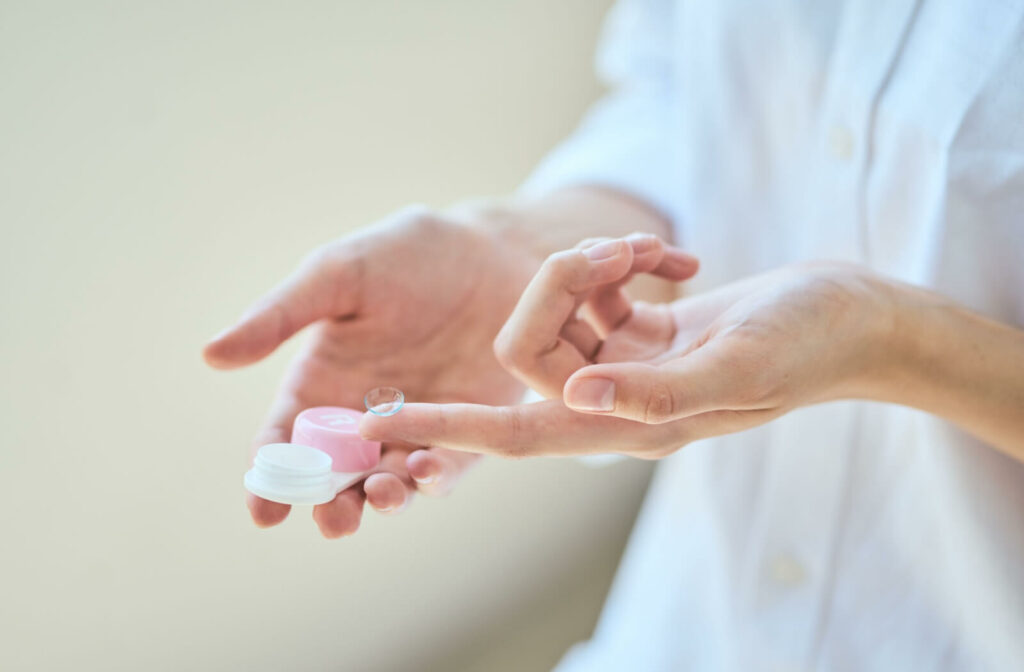If you’re a contact lens wearer experiencing dry, itchy eyes, you might wonder if your lenses are the culprit. Dry eye disease is a common condition that affects millions of people, impacting their daily comfort and vision quality.
Unfortunately, sometimes contacts are the culprit behind temporary and chronic dry eye, either because of the type of contact or because they’re being worn for too long a time. Fortunately, the solutions to these problems don’t require you to stop using contact lenses.
What is Dry Eye Disease?
Dry eye disease is a condition in which the eyes don’t produce enough tears or the tears that are reproduced evaporate too quickly. This leads to inflammation and discomfort and can also cause vision problems. Over 16 million Americans are impacted by dry eye, so know that you’re not alone.
Dry eye symptoms generally occur in both eyes and include:
- Stinging or burning
- Gritty or scratchy feeling
- Foreign body sensation
- Red or watery eyes
- Blurry vision
- Sensitivity to light
- Eye fatigue
- Stringy mucus in or around your eyes
- Discomfort when wearing contacts
Depending on the underlying causes, the condition can be temporary or chronic.
Risk Factors for Dry Eye Disease
While anyone can develop dry eye disease, certain factors increase the risk, including using contact lenses. Understanding these factors can help you identify if you’re at risk or if your current lifestyle may exacerbate your symptoms.
- Age is a significant factor in dry eye, with older adults experiencing reduced tear production. This natural decline makes them more prone to dry eyes, especially when combined with other risk factors.
- Chronic health conditions like diabetes, thyroid disorders, and autoimmune diseases can increase susceptibility.
- Gender plays a role as well. Women, particularly those undergoing menopause or pregnancy, may experience hormonal fluctuations that affect tear production.
- Certain medications, such as antihistamines, antidepressants, and blood pressure medications, can also decrease tear production or alter tear composition.
- Environmental influences, such as dry climates or exposure to smoke, can exacerbate symptoms.
- Prolonged computer use can lead to decreased blinking and increased tear evaporation.
Being aware of these risks can guide preventive measures and lifestyle adjustments.
What Is Contact Lens-Induced Dry Eye?
Contact lens-induced dry eye is a subset of dry eye disease associated with contact lens wear. Wearing lenses can affect the ocular surface and tear film stability, resulting in insufficient moisture on the eye’s surface, which can lead to discomfort and dryness.
The material of the contact lens plays a significant role in moisture retention. Some materials may absorb moisture from the tear film, exacerbating dryness. Additionally, lenses with low oxygen permeability can restrict airflow to the cornea, contributing to discomfort and dryness.
Symptoms of this condition include dryness, irritation, and the sensation of a foreign body being in the eye. Vision may become blurred, and redness or discomfort can occur, particularly towards the end of the day.
Improper lens care and wearing habits can also contribute to dry eye symptoms. Overwearing lenses or failing to clean them properly can lead to protein deposits on the lens surface. These deposits can irritate the eye and exacerbate dryness. Ensuring proper lens hygiene and adhering to recommended wear times can help mitigate these effects.
How Do You Treat Dry Eyes from Contacts?
Treating dry eyes caused by contact lenses involves a combination of proper lens care, lifestyle adjustments, and potential product changes.

- Follow recommended lens wear schedules and hygiene practices, including correctly cleaning and storing reusable lenses.
- Over-the-counter artificial tears can provide relief by supplementing your natural tear production. These drops help maintain moisture and reduce irritation. However, be sure to choose preservative-free options, as preservatives can potentially worsen dry eye symptoms.
In cases where lifestyle changes and over-the-counter solutions are insufficient, consult an eye care professional. They can recommend prescription treatments or advise on changes to your current contact lens brand or routine. Consistency and attention to eye health can significantly alleviate symptoms.
Contact Lenses Made for Dry Eye
If you suffer from contact lens-induced dry eye, consider switching to lenses specifically designed with materials that enhance moisture retention and comfort.
- Daily disposable lenses reduce the buildup of deposits and allergens, providing a fresh lens daily. This can help maintain moisture levels and reduce irritation, especially for sensitive eyes.
- Silicone hydrogel lenses are another option, allowing more oxygen to reach the cornea. This increased oxygen permeability can improve comfort and reduce the risk of dryness.
- Some lenses also incorporate wetting agents, which enhance moisture retention and provide additional lubrication to the eye’s surface.
Tips to Avoid Dry Eye When Wearing Contact Lenses
Beyond switching the type of contacts you’re wearing, you can adopt several additional strategies to minimize dry eye symptoms while wearing contact lenses, including:
- Using a humidifier to help keep the air moist, thereby reducing tear evaporation.
- Blinking regularly, especially when using computers or digital devices. This simple action helps spread tears across the eye’s surface, maintaining moisture and reducing strain.
- Taking regular breaks from screens can also alleviate eye fatigue.
- Drinking plenty of water throughout the day to stay hydrated. Proper hydration supports tear production and overall eye health.
- Rewetting drops can be used to maintain comfort and clarity for lens wearers.
Valley Eye and Vision Clinic understands that dry eye disease is a common concern among contact lens wearers, but it can be managed with the right approach. Contact us today to book a contact lens exam so we can get you lenses that provide you with the most possible comfort.


